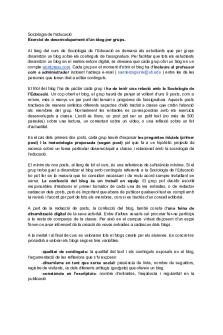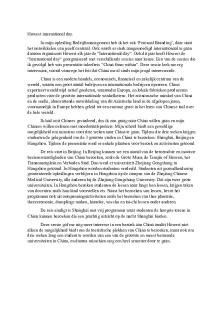Art Blog 1-Persephone & Hades PDF

| Title | Art Blog 1-Persephone & Hades |
|---|---|
| Author | Divya Varde |
| Course | Classical Mythology |
| Institution | University of Maryland Baltimore County |
| Pages | 2 |
| File Size | 142.8 KB |
| File Type | |
| Total Downloads | 40 |
| Total Views | 152 |
Summary
Art Blog Assignment 1
Picture: The Return of Persephone, Athenian red-figure bell krater C 5 th B.C., Metropolitan Museum of Art
...
Description
Art Blog 1
Divya Varde
The Return of Persephone, Athenian red-figure bell krater C 5th B.C., Metropolitan Museum of Art
The myth of Persephone and Hades provides the explanation of nature’s eternal cycle— birth and death. Persephone, the daughter of Demeter, who was Zeus’ sister, was known to be the goddess of spring growth and, eventually, the goddess of the underground world. Persephone’s mother, Demeter, was highly protective of her, always keeping her by her side, and flowered her with love and kindness. One odd day, Hades, who was known as the god of the underworld, had made a trip above ground and was enchanted by Persephone, who was gathering flowers in the meadow for her mother. He was determined to have her as his wife and thus requested Zeus’ help to kidnap Persephone into the underworld. Agreeing to his brother’s wishes, Zeus noticed Persephone picking flowers with her friends, and caused the ground underneath her to split open; inevitably dropping Persephone into Hades underground kingdom. Demeter, distraught and lost without her daughter, went on a hunt to find Persephone. Later, it was revealed to her that Zeus had played a role in abducting her daughter per Hades wishes. As retaliation, Demeter vowed to not allow the harvest to flourish. Taken against her will, Persephone refused offerings of food and love from Hades. Overtime, Persephone had warmed up to Hades and allowed him to take her throughout his underground world. In his attempt to win her over, Hades had persuaded Persephone to eat six pomegranate seeds—little did she know, once she ate the seeds, she was now committed to the underworld. Upon eating the seeds, Hermes appeared before her and told her about the situation above ground. The end solution determined by Zeus, was that since Persephone has eaten 6 seeds, she will spend 6 months with Demeter above ground and the other 6 months with Hades in the underworld. This is where the nature’s spring/summer and fall/winter comes into play. Whenever Persephone returns to Demeter, the harvest and plants flourish—the birth of nature; when
Art Blog 1
Divya Varde
Persephone returns back to the underworld, the plants and life wither away—the death of nature. In the picture above, Hermes, standing beside Persephone, is shown as bringing her back above ground. Across Persephone, Hecate is shown carrying torches to bring light to Persephone’s journey underground.
Sources: http://www.theoi.com/Khthonios/HaidesPersephone1.html https://sites.psu.edu/tetirclblog/2015/02/05/greek-mythology-hades-andpersephone/comment-page-1/ https://www.greeka.com/greece-myths/persephone.htm http://www.theoi.com/Khthonios/Persephone.html https://www.greekmyths-greekmythology.com/myth-of-hades-and-persephone/...
Similar Free PDFs

Art Blog 1-Persephone & Hades
- 2 Pages

Hermes, Hades, Poseidón
- 11 Pages

BLOG 1 - BLOG
- 3 Pages

Evidence Blog Pet peeves blog
- 1 Pages

12min Blog
- 4 Pages

Exercici blog
- 2 Pages

Week5 - blog
- 6 Pages

Discussion Blog
- 1 Pages

Spanish blog - Grade: A
- 1 Pages

Blog actividad 3 sena
- 2 Pages

Kopi Time - Marketing BLOG
- 7 Pages

Blog Marketing Literature Review
- 10 Pages

Blog Howest international day
- 1 Pages

Evidence Blog Presentations
- 2 Pages
Popular Institutions
- Tinajero National High School - Annex
- Politeknik Caltex Riau
- Yokohama City University
- SGT University
- University of Al-Qadisiyah
- Divine Word College of Vigan
- Techniek College Rotterdam
- Universidade de Santiago
- Universiti Teknologi MARA Cawangan Johor Kampus Pasir Gudang
- Poltekkes Kemenkes Yogyakarta
- Baguio City National High School
- Colegio san marcos
- preparatoria uno
- Centro de Bachillerato Tecnológico Industrial y de Servicios No. 107
- Dalian Maritime University
- Quang Trung Secondary School
- Colegio Tecnológico en Informática
- Corporación Regional de Educación Superior
- Grupo CEDVA
- Dar Al Uloom University
- Centro de Estudios Preuniversitarios de la Universidad Nacional de Ingeniería
- 上智大学
- Aakash International School, Nuna Majara
- San Felipe Neri Catholic School
- Kang Chiao International School - New Taipei City
- Misamis Occidental National High School
- Institución Educativa Escuela Normal Juan Ladrilleros
- Kolehiyo ng Pantukan
- Batanes State College
- Instituto Continental
- Sekolah Menengah Kejuruan Kesehatan Kaltara (Tarakan)
- Colegio de La Inmaculada Concepcion - Cebu

